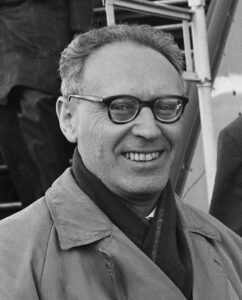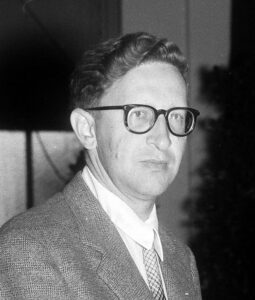FIDE World Chess Championship 1954
← Previous | Timeline | Next →
The FIDE World Chess Championship 1954 took place in Moscow, Soviet Union, between reigning champion Mikhail Botvinnik and challenger Vasily Smyslov, both representing the Soviet Union. The 24-game match ended in a 12–12 tie, allowing Botvinnik to retain his title.

Photographer: Harry Pot / Anefo (License: CC BY-SA 3.0 NL) via Wikimedia Commons
Winner/Reigning Champion: Mikhail Botvinnik
Born: 17 August 1911, Kuokkala (now Repino, Russia)
Died: 5 May 1995, Moscow, Russia
By 1954, Mikhail Botvinnik had firmly established himself as the intellectual and strategic leader of Soviet chess. A product of scientific discipline, meticulous preparation, and institutional support, he entered the match as the reigning champion, having won the 1948 FIDE World Championship and defended his title in 1951 after a drawn match with David Bronstein.
His approach to chess was deeply analytical — guided by the belief that chess is a science — yet his play often revealed flashes of creative intuition. Against Smyslov, he faced one of the few players capable of matching both his calculation and his understanding of long-term positional play. Despite trailing midway, Botvinnik displayed remarkable resilience and adaptability, ultimately holding the match to a draw and retaining his crown.
The 1954 contest solidified Botvinnik’s reputation as a pioneering theorist, mentor, and architect of the Soviet chess school that would dominate for decades.
“Smyslov had an extraordinary ability to play effortlessly, yet with deep strategic purpose. His style was a challenge even to the most prepared opponent.”
— Mikhail Botvinnik

Photographer: van Duinen / Anefo (License: CC0 1.0) via Wikimedia Commons
Challenger: Vasily Smyslov
Born: 24 March 1921, Moscow, Soviet Union
Died: 27 March 2010, Moscow, Russia
Vasily Smyslov entered the 1954 championship as a confident and mature challenger. After his commanding victory at the 1953 Candidates Tournament in Zurich — where he showcased classical balance and endgame mastery — he was seen as the natural successor to Botvinnik.
Renowned for his harmonious, effortless-looking play, Smyslov emphasized coordination, timing, and clarity of purpose over brute-force calculation. His musical sensibility often echoed in his chess: calm, refined, and elegant. During the 1954 match, he repeatedly unsettled Botvinnik with well-structured plans and near-perfect endgame technique. Though the match ended in a tie, Smyslov’s reputation soared, and many believed it was only a matter of time before he would capture the title — which he did three years later in 1957.
“Chess is an art, and my goal is to create harmonious positions where every piece has its purpose.” — Vasily Smyslov
Match Overview
Match Dates: March 16 – May 13, 1954
Location: Moscow, Soviet Union
Format: Best of 24 games (Champion retains title if tied)
Time Control: 40 moves in 2.5 hours, followed by 16 moves per hour (no increment)
Prize Fund: Modest state-funded stipends and honorary awards; no official public figures disclosed
Main Sponsors:USSR Sports Committee, Soviet Chess Federation (FIDE-sanctioned
Historical and Cultural Context
The 1954 World Championship unfolded at the height of the Cold War, when chess was both a scientific discipline and an ideological showcase. Within the Soviet Union, the match carried enormous prestige — a demonstration of intellectual supremacy and internal competition between two Soviet masters.
Smyslov’s intuitive artistry contrasted with Botvinnik’s systematic, scientific approach, mirroring deeper philosophical debates within Soviet academia and culture. The match captivated the Soviet public and drew limited but intense international coverage.
The final 12–12 score reflected both the depth of Soviet chess training and the delicate balance between two of its finest minds — a duel that would shape the narrative of world chess for the next decade.

World Chess Championship 1954 Games
Game 1
Game 2
Game 3
Game 4
Game 5
Game 6
Game 7
Game 8
Game 9
Game 10
Game 11
Game 12
Game 13
Game 14
Game 15
Game 16
Game 17
Game 18
Game 19
Game 20
Game 21
Game 22
Game 23
Game 24
FIDE World Chess Championship 1954
Mikhail Botvinnik, Soviet Union
← Previous | Timeline | Next →
FIDE World Chess Championship 1954 Sources
Sources for Quotes
- Smyslov, My Best Games by Vasily Smyslov
- Analytical and Critical Work by Mikhail Botvinnik
General Sources
- FIDE Archives: Official match documents and announcements
- ChessBase: World Championship 1954 overview and analysis
- Wikipedia:
- ChessHistory.com: Edward Winter’s articles on Botvinnik and Smyslov
- British Chess Magazine: Issues from March to May 1954 (archive-only)
- Shakhmaty v SSSR: Soviet chess magazine coverage from 1954 (translated excerpts)
- New in Chess Magazine: World Championship retrospectives (print/online, 2004 edition)
- Kasparov, Garry: My Great Predecessors, Part II (2003, Everyman)
- Mark Weeks: World Chess Championship 1954 overview
Photo Credits
Mikhail Botvinnik at Schiphol Airport, 1962
Photographer: Harry Pot / Anefo (License: CC BY-SA 3.0 NL) via Wikimedia Commons
Date: 29 October 1962
Vassily Smyslov in 1954
Photographer: van Duinen / Anefo (License: CC0 1.0) via Wikimedia Commons
Date: 7 September 1954
Sources, image credits, and attributions for this championship are listed on this page. For general information about the World Chess Champions timeline, visit the main page.